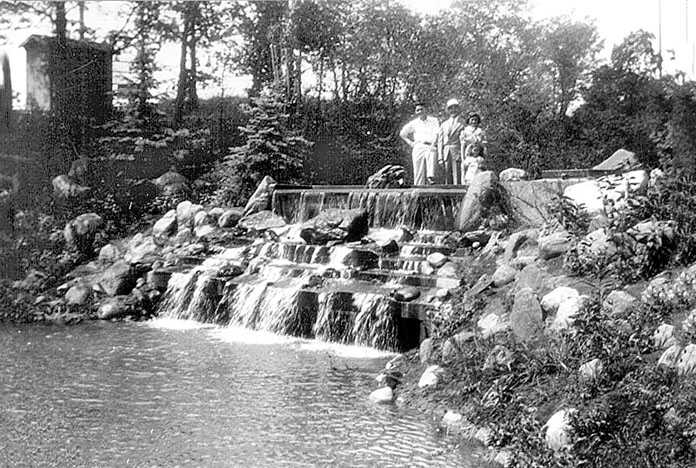Although this mill was located in Edina, it ran on the water from the Minnehaha Creek that came from St. Louis Park.
Waterville Mill, located beside the dam where Browndale Avenue crosses Minnehaha Creek at 50th Street, was built in 1857 by William Marriott. The year before, George Drew had given Richard Strout and Co. “all the water in Little Falls Creek… necessary to raise water at mill to obtain 14 feet head with additional right and privileges of raising water 3 feet higher from October 15 to April 15 annually, all of which said water is to be applied to milling purposes in connection with mill and dam to be built by (Strout and Co.) within one year on land formerly owned by William Hoit” [preempted by Isaac Draper and sold a few months later to Strout and Co.] Legend has it that Strout bought the mill from William Marriott for a cow.
In 1859, Strout sold the mill and 160 acres to Jonathan T. Grimes and William Rheen, who built a new dam. Rheen soon departed back to Pennsylvania and Grimes ran both the mill and the farm. The mill (also known as the Red Mill) was used by local farmers and Indians to mill their wheat, rye, barley, and corn, for their own use and for sale to Fort Snelling. The mill was known for producing feed, flour, and grain, and was the only mill in the State to produce oatmeal and pearl barley. During the Civil War, Jonathan Grimes would deliver flour to Fort Snelling. His horses knew the way home and he could sleep in the wagon bed. The farmland became the present-day Morningside neighborhood of Edina.
In 1866, Grimes sold the mill to James Baird.
In 1867, the mill was bought by Daniel H. Buckwalter and became known as the Buckwalter Mill.
In 1869, Andrew Craik came to Minneapolis and bought the Buckwalter Mill, which he named the Edina Mills after an 1856 poem by Robert Burns called “Address to Edinburgh.” Craik was born in Edinborough, Scotland, in 1817 and he died in 1892. He was educated in Canada and operated his father’s gristmill at age 16. He served in the Canadian Army until 1841, and went into the flour mill business in LaCrosse, Wisconsin, in 1861. He had four daughters: Agnes, Lillie, Mamie, and Florence.
In 1875, Craik sold the mill to George Millam, who had operated the mill for 20 years and was known as the “Edina Miller.” [1869-1918] In 1889 Millam sold the mill to Henry F. Brown, uncle of Earle Brown, Sheriff of Hennepin County.
Over the years the need for milling decreased, as did the water level of the creek. A note in the 1894 Mail newspaper described the water in Minnehaha Creek as “so high that the falls here quite rival that of the Minnehaha.” A dam was built in 1895 at Gray’s Bay at the source of the Creek, lowering the water level and dooming all of the creek’s mills. The mill ground feed for cattle for awhile, but it was eventually abandoned in 1918 and was demolished in 1932. There is an excellent presentation of the mill at the site itself, and more information at the Edina Historical Society.
THE CASCADES
This is not to be confused with the Cascades, which is also in Edina, along the creek on the west side of Highway 100. It was built by a group of homeowners who, when the creek was low, had a well and the falls put in to keep the level west of Highway 100 from getting too low. Kids would go fishing there in the summer and catch catfish.

In the 1980s, neighbors made an attempt to save the ruins of the Cascades when the City of Edina proposed demolition. Cascade Lane is in the area of the place, but it isn’t really accessible due to the configuration of the highway.

